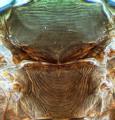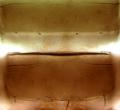Erythrothrips arizonae
Recognition data
Distinguishing features
Both sexes fully winged. Body, legs and antennae brown, except yellow basal half of antennal segment III; fore wing pale with posterior half dark including clavus. Antennae 9-segmented, VII–IX forming a unit with IX much shorter than VIII; sensoria on III–IV linear, on III usually 0.4 as long as segment, on IV more than 0.5. Head and pronotum with no long setae. Fore tarsus with hamus small. Metanotum with one pair of setae at anterior margin and one pair near posterior, sculpture weakly arcuate around anterior margin. Fore wing slender with apex rounded. Abdominal tergites IV–VI without sculpture medially; trichobothria on X very small. Sternites IV–VI each with two pairs of posteromarginal setae and 12 to 14 setae on discal area, chaetotaxy on VII similar with two pairs of supernumerary setae submarginally.
Male similar to female but abdomen more slender; tergite I with pair of short longitudinal ridges.
Related and similar species
A total of 12 species is listed currently in the genus Erythrothrips, although two of these (E. bishoppi from Texas and E. fasciculatus from California) cannot at present be distinguished satisfactorily from E. arizonae and these are all likely to represent the same species. Of the remaining nine species, one is from California, one from Argentina, two from Brazil, three from Peru, and two from Mexico (although these last two are also likely to represent a single species) (Mound & Marullo, 1993). The name E. fasciculatus is applied to relatively small specimens in which the sensorium on antennal segment III is scarcely 0.3 as long as the segment, but these specimens have been taken from the same host plant, Adenostoma, as E. arizonae.
Taxonomic data
Current valid name
Erythrothrips arizonae Moulton
Original name and synonyms
- Erythrothrips arizonae Moulton, 1911: 21
Family placement
Aeolothripidae
Biological data
Life history
Bailey (1957) indicates that the larva spins a pupal cocoon, and that the adults are found in spring in California. Adults and larvae are possibly predatory on the larvae of other thrips.
Host plants
Yucca brevifolia (Agavaceae); Adenostoma fasciculatum (Rosaceae)
Tospoviruses vectored
None
Crop damage
None
Distribution data
Area of origin
Western USA
Distribution
California, Arizona, Nevada, Mexico.







